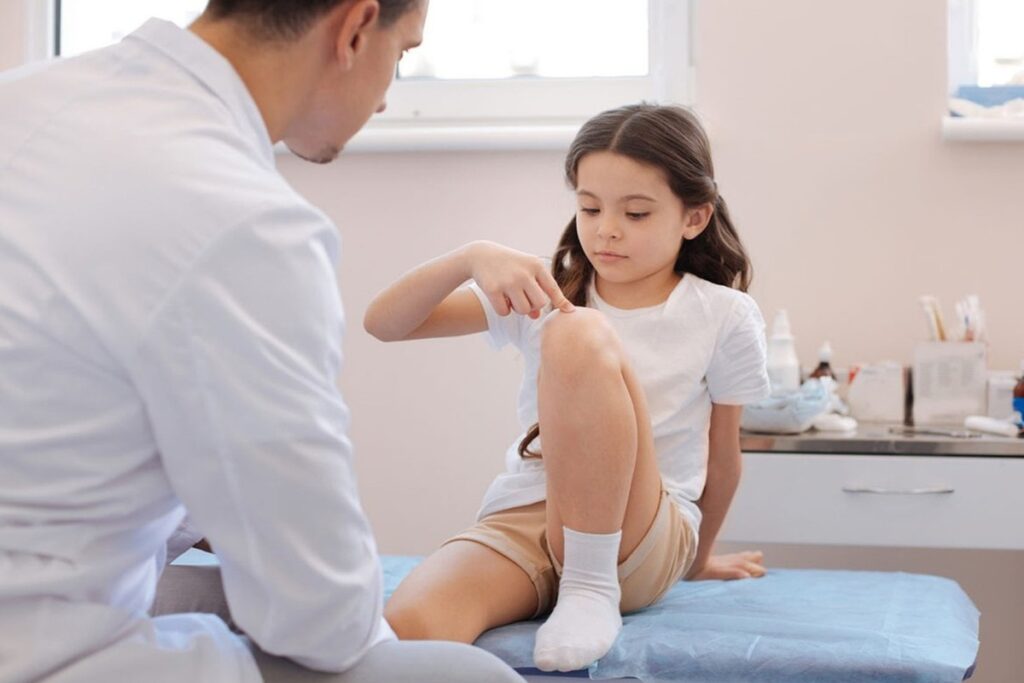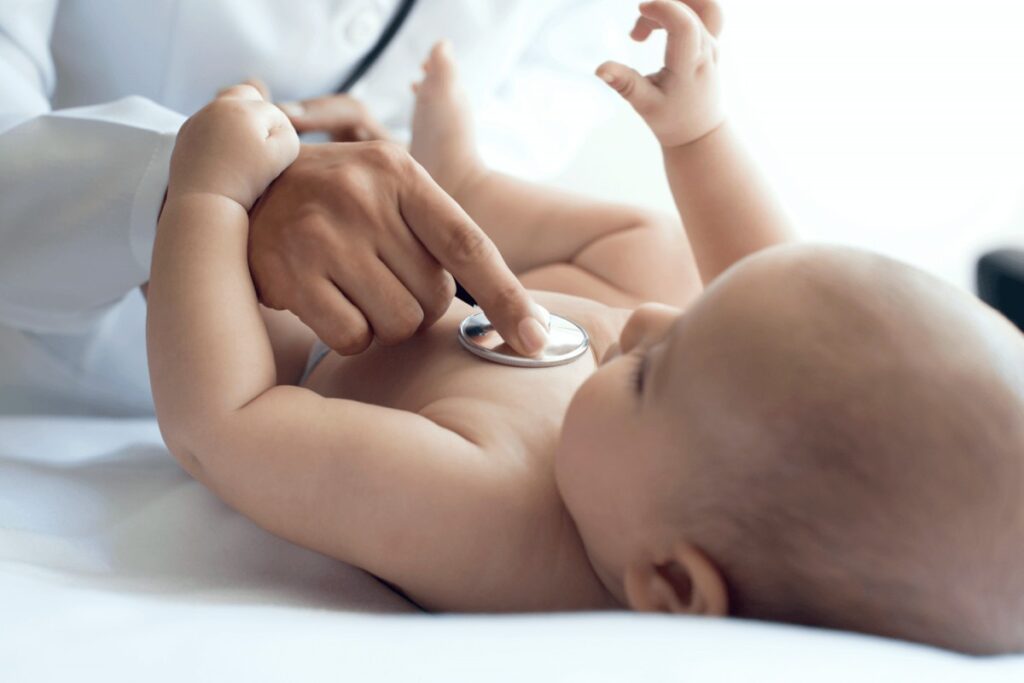Last Updated on October 21, 2025 by mcelik
Hernias in kids are more common than many parents think. Most cases are either inguinal hernias or umbilical hernias. A hernia happens when the abdominal wall has a weakness or defect. This lets tissue or fat bulge out, making a noticeable lump.

While hernias are more common in adults, they can also happen in children and babies. It’s important for parents and caregivers to know about the different pediatric hernia types. This helps them spot the signs early and get the right medical care.
Recent studies have looked into how common hernias are in kids. Knowing these numbers helps doctors figure out risks and plan treatments.
Research shows that about 0.8% to 5% of kids get inguinal hernias. Inguinal hernias affect 1% to 5% of infants and children. Premature babies are more likely to get them. This shows we need more research on why hernias happen in kids.
There’s a big difference in who gets hernias. About 78% of cases are in males. This is something doctors need to think about when they diagnose and treat hernias in kids.
Age plays a big role in hernias in kids. Premature babies are at a higher risk. As kids get older, the chance of getting a hernia goes down. Knowing this helps doctors catch and treat hernias early.
Important facts about pediatric hernias include:
Looking at these numbers helps us understand more about pediatric hernias. It guides doctors and helps parents, too.
The most common hernias in kids are inguinal hernias and umbilical hernias. Each has its own features and how often they happen.
Inguinal hernias are found in the groin area. They happen when part of the intestine bulges through a weak spot in the muscles. Inguinal hernias are more common in boys and are often linked to premature birth.
Some important facts about inguinal hernias in kids are:

Umbilical hernias happen near the belly button, are common in newborns and young babies. They are caused by a weak spot in the muscles around the navel. Unlike inguinal hernias, umbilical hernias are more noticeable when the child coughs, cries, or strains.
Umbilical hernias have these characteristics:
Hernias above the belly button are less common but can happen in children. These hernias, known as epigastric hernias, occur when there is a weak spot in the abdominal wall between the navel and the chest.
Important points about hernias above the belly button are:
In conclusion, knowing about the different hernias in children is key for parents and caregivers. While inguinal and umbilical hernias are common, recognizing the signs and symptoms can help get medical help quickly.
Pediatric hernias are caused by prenatal and postnatal factors. Knowing these risk factors helps in the early detection and treatment of hernias in kids.
Premature birth is a big risk for hernias in kids. Preterm babies have weak abdominal walls, making them more likely to get hernias. Studies show preterm babies have a higher risk of hernias than full-term babies. Their weak muscles and need for medical procedures add to this risk.
Certain genetic conditions or abnormalities can lead to pediatric hernias. Children with these conditions are more likely to get hernias. It’s important to watch children with these conditions for signs of hernias.
Medical conditions can also lead to hernias in kids. For example, chronic coughing or constipation can increase the risk. Children with connective tissue issues are also more prone to hernias.
Some hernias might heal on their own, but not all. Whether a hernia can heal itself depends on the type and the child’s health. Often, surgery is needed to fix the hernia and avoid complications.
Understanding the risk factors for pediatric hernias helps parents and doctors manage these conditions. Early detection and treatment are vital for the best outcomes in children with hernias.
It’s important for parents to know the signs of hernias in kids. This helps them get the right medical help. Hernias in children show different signs and symptoms that need attention.
A common sign of a hernia in kids is a bulge or lump. This is often seen in the groin for inguinal hernias or near the belly button for umbilical hernias. The bulge gets bigger when the child coughs, strains, or stands up.
Key physical signs include:

Kids with hernias might feel uncomfortable or in pain. This pain can be constant or come and go. It often gets worse when they do activities that put pressure on their belly.
Discomfort indicators can include:
It’s key to watch for signs of complications like incarceration or strangulation. These signs need quick medical help.
Warning signs for complications include:
Spotting these signs early can help a lot. If you think your child has a hernia or shows these symptoms, see a doctor right away.
Untreated hernias can be very dangerous for kids. They might lead to serious health problems. These issues could need quick medical help.
Incarceration is a serious problem in about 11-13% of infant cases. It happens when tissue gets trapped and can’t go back inside. This can cause a lot of pain and discomfort.
Incarceration risks are higher in some hernias, like inguinal ones. It’s important for parents to watch their child closely. If they see signs like more pain or swelling, they should get medical help fast.
Strangulation is a very serious issue. It happens when blood can’t reach the herniated tissue. This is a medical emergency that needs quick action.
Signs of strangulation include severe pain, vomiting, and fever. If a child shows these symptoms, parents should get medical help right away.
Untreated hernias can also cause long-term health problems. Kids might experience chronic pain and discomfort. This can really affect their quality of life.
It’s key for kids with hernias to get the right medical care. Early treatment can prevent serious complications. This helps ensure better health outcomes for kids.
Getting a correct diagnosis is key to treating hernias in kids. It involves physical exams and sometimes imaging studies. We’ll go over how to diagnose pediatric hernias. This will help you understand the whole process.
Diagnosing hernias in kids starts with a detailed physical exam. We look for signs like bulges or swelling, which show up when they cough or strain. The exam is done in different positions to see how the hernia acts.
Key aspects of the physical examination include:
Physical exams usually do the trick for diagnosing hernias. But sometimes, imaging studies are needed to confirm or check for complications. Imaging techniques like ultrasound are used because they’re safe and don’t use radiation.
Ultrasound is great for looking at what’s inside the hernia. It helps us see if there are any serious problems like incarceration or strangulation.
Differential diagnosis is a big part of diagnosing hernias. It’s about ruling out other conditions that might look like a hernia. This makes sure the child gets the right treatment.
Conditions that may be considered in the differential diagnosis include:
By looking closely at the child’s symptoms and doing the right exams and tests, we can find out if they have a hernia. Then, we can plan the best treatment.
Managing pediatric hernias requires different strategies. These range from watching the condition to surgical repair. The right treatment depends on the hernia type, its size, and the child’s health.
Small, painless hernias might be treated with watchful waiting. Watchful waiting is often used for umbilical hernias. Many close on their own by age 3 to 5.
Parents can help by avoiding heavy lifting. But they should watch for signs of trouble and seek help if needed.
Large or painful hernias usually need surgery. Surgical approaches have improved, with less invasive methods. These include laparoscopic surgery.
Laparoscopic hernia repair uses small incisions. It leads to less pain, quicker healing, and less scarring.
Recovery from hernia surgery is usually quick. Most kids can go back to normal in a few days. Pain management is key, with most needing little pain medication.
Surgical repair has great results for kids. Minimal complications and low recurrence rates are common. The outcome depends on the hernia, the surgery, and the child’s health.
In summary, treating pediatric hernias needs a personalized plan. By picking the right treatment, doctors can help kids get better fast.
Hernias in kids are more common than you might think. It’s key to know the signs and symptoms early. A bulging belly button or a swollen tummy in babies could mean a hernia.
We talked about the different kinds of hernias in children. These include inguinal and umbilical hernias. We also looked at what increases the chance of getting one. Spotting the signs, like visible bulges or pain, is vital for parents to get help.
With the right treatment, hernias in kids can be fixed. This helps avoid serious problems. We stress the need for quick medical help if symptoms don’t go away. This ensures the best care for kids with hernias.
A pediatric hernia occurs when the abdominal wall has a weakness. This allows tissue or fat to bulge out. It can happen in the groin, belly button, or above it.
Hernias are quite common in kids, with inguinal hernias being the most common. The chance of getting a hernia depends on age, gender, and other factors.
Signs include a bulge or lump, pain, and sometimes warning signs for serious problems.
Some hernias, like umbilical ones, might close by themselves as the child grows. But inguinal hernias usually need surgery to avoid serious issues.
Not treating hernias can lead to serious problems. These include the tissue getting trapped or the blood supply being cut off. Both are serious health risks.
Doctors use a physical exam and sometimes imaging studies to diagnose hernias. They also check for other conditions to make sure.
Treatment can be watching the condition or surgery, depending on the type and size of the hernia. The decision is based on the child’s health and the hernia’s details.
Recovery starts with rest and then slowly getting back to normal. Most kids do well after surgery and don’t have lasting problems.
Most kids with hernias don’t have long-term health issues if treated right. But untreated or recurring hernias can cause serious problems.
Yes, premature birth is a risk factor for hernias, like inguinal ones. This is because the abdominal wall might not close fully.
A strangulated hernia occurs when the blood supply is cut off. Symptoms include severe pain, nausea, vomiting, and a swollen hernia. It’s a medical emergency.
Small umbilical hernias with fat might be watched without surgery. But, bigger ones or those causing symptoms usually need surgery.
Subscribe to our e-newsletter to stay informed about the latest innovations in the world of health and exclusive offers!
WhatsApp us